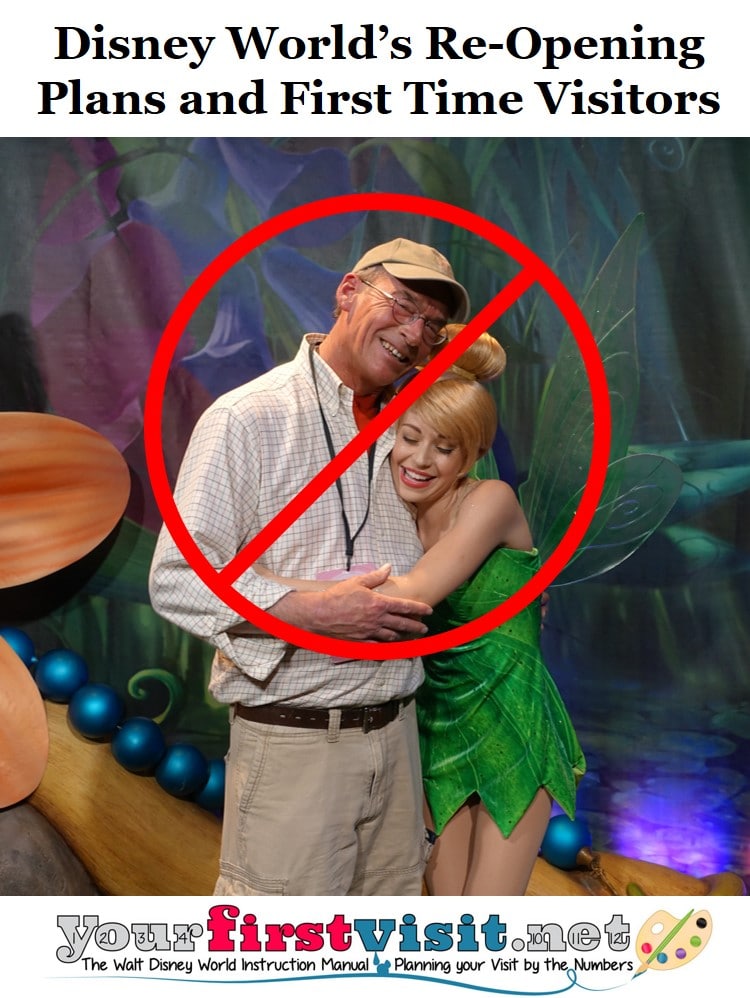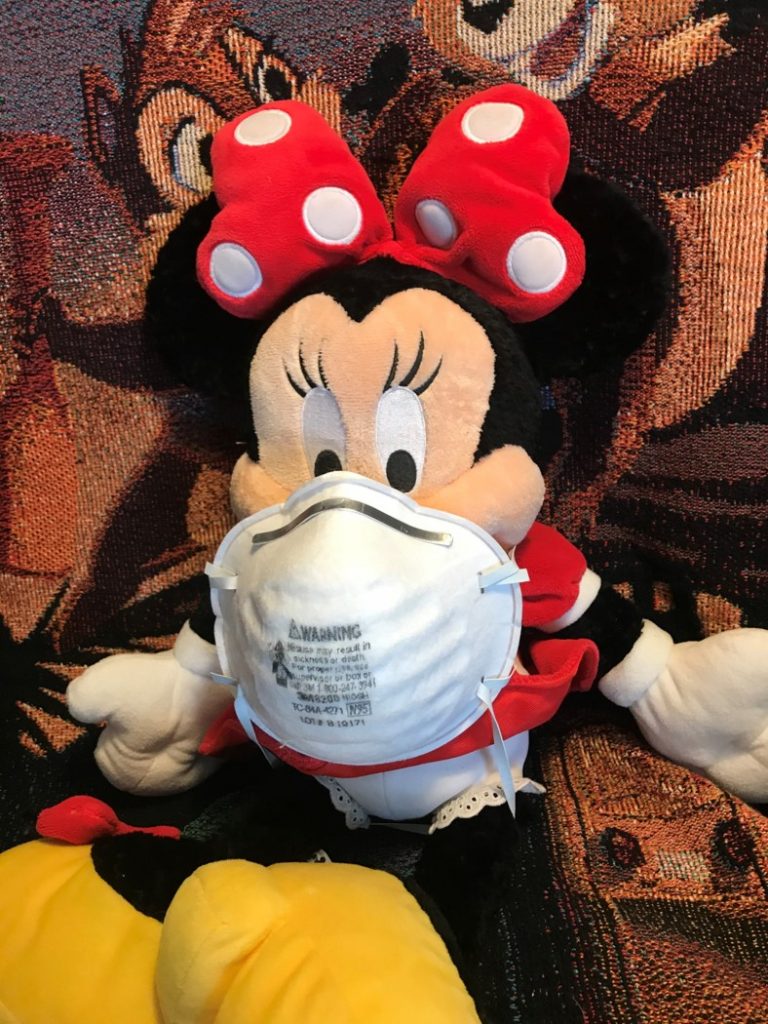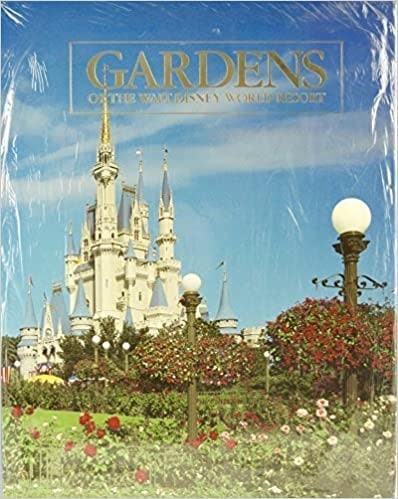Category — w. Most Recent Stuff
A Friday Visit with Jim Korkis: Camp Minnie-Mickey
Welcome back to Fridays with Jim Korkis! Jim, the dean of Disney historians, writes about Walt Disney World history every Friday on yourfirstvisit.net.
CAMP MINNIE-MICKEY
By Jim Korkis
Although Camp Minnie-Mickey in Disney’s Animal Kingdom was meant to be a temporary placeholder, it lasted from 1998 to 2014, almost 16 years, when it was replaced by Pandora: The World of Avatar.
During final planning and construction, Disney’s Animal Kingdom faced unexpected budget overruns, so cuts had to be made including an entire land called Beastly Kingdom. Realizing there would be not enough shows and attractions on opening day, CEO Michael Eisner recalled Mickey’s Birthdayland, a temporary location built in only ninety days in 1988 at the Magic Kingdom. Eisner felt that something similar devoted to Disney characters could mimic that success.
The Disney’s Animal Kingdom design team was appalled that the Beastly Kingdom had been cut and told Eisner they were too busy with the other areas of the park to work on the placeholder, so Entertainment and some outside developers took over the assignment. There was no time or money to build attractions, so they concentrated on shows and meet-and-greet opportunities.
It was hoped that once the new park was a success that there would be an influx of revenue to build Beastly Kingdom and Camp Minnie-Mickey would disappear. That didn’t happen.
Camp Minnie-Mickey was themed to be a rural summer fishing camp in the woodlands of the Adirondack Mountains in upstate New York, where the characters were on vacation. This theme was echoed in the landscape, architecture, and street furniture that provided a homemade feeling.
At the Greeting Trails guests could usually find Mickey, Minnie, Donald and Goofy. In random places throughout the land other characters like Chip, Dale, Koda, Pocahontas, Meeko, Baloo, an King Louie, among others, appeared.
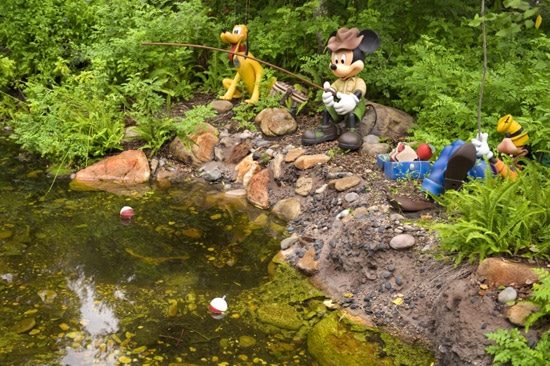
(c) Disney
Along the river were three-dimensional fiberglass figures of Donald Duck fishing and catching a rubber boot; Mickey, Pluto and Goofy fishing; and Huey, Dewey, and Louie hiking with Daisy Duck.
The camp’s assembly hall seating 1,375 guests was the original home for the half hour The Festival of the Lion King musicial show. This show did not tell an abbreviated version of the famous animated feature’s plot, but rather was a tune-filled tribal celebration with audience participation and some unexpected surprises.
Hosted by four human performers with Swahili names and attired as traditional African tribal leaders, they prompted the guests on how to participate with the performers several times during the show.
The impressive floats that served as intriguing set pieces were actually recycled and modified from The Lion King Celebration parade that ran at Disneyland from 1994-1997.
The other show in Camp Minnie-Mickey was the twelve minute Pocahontas and Her Forest Friends, in Grandma Willow’s Grove. The genesis of the show came from the animal education cast at Disney’s Animal Kingdom. It was meant to be similar to animal meet-and-greet shows at zoos and other animal parks, where a trainer or two brings out one animal at a time and talks about the animal’s characteristics to the audience.
In the Disney’s Animal Kingdom version, Pocahontas is worried that the forest is being cut down indiscriminately and runs to Grandma Willow for advice. She reminds Pocahontas of a prophecy that one creature has a special gift to protect the forest but that Pocahontas herself must discover the identity of that creature giving her the opportunity to interact with several different animals including a raccoon, a snake, rabbits, opossums, a skunk, and a porcupine–and in the process educate the audience about them.
This show was the only part of Disney’s Animal Kingdom that showcased animals from North America.
While there was no restaurant in the land, guests could get cookies and ice cream sandwiches at Camp Soft Serve (also known as Chip and Dale’s Cookie Cabin) and at Campfire Treats (also known as Campside Funnel Cakes) get funnel cakes, corn dogs and beverages.
The main reminder of Camp Minnie-Mickey is Festival of the Lion King, now in its own space in Africa.
* * * * *
Thanks, Jim! And come back next Friday for more from Jim Korkis!
In the meantime, check out his books, including his latest, Disney Never Lands, and about planned but unbuilt concepts, and Secret Stories of Walt Disney World: Things You Never You Never Knew, which reprints much material first written for this site, all published by Theme Park Press.
Follow yourfirstvisit.net on Facebook or Twitter or Pinterest!!
June 19, 2020 No Comments
A Friday Visit with Jim Korkis: The “Extinct” Shows of Theater in the Wild
Welcome back to Fridays with Jim Korkis! Jim, the dean of Disney historians, writes about Walt Disney World history every Friday on yourfirstvisit.net.
THE FORMER SHOWS OF THEATER IN THE WILD
By Jim Korkis
Imagineer Alex Wright said, “Theater in the Wild is not really part of the lands of Animal Kingdom. Even its name is intended to reflect the idea that it’s an entity unto itself. It offers a performance space that can be used for shows that might not fit very well into any of the established storylines.”
The 1,500 seat Theater in the Wild in the Dinoland USA area of Disney’s Animal Kingdom has featured three stage shows: Journey into the Jungle Book (1998-1999), Tarzan Rocks! (1999-2006), and Finding Nemo – The Musical (2007-Present).
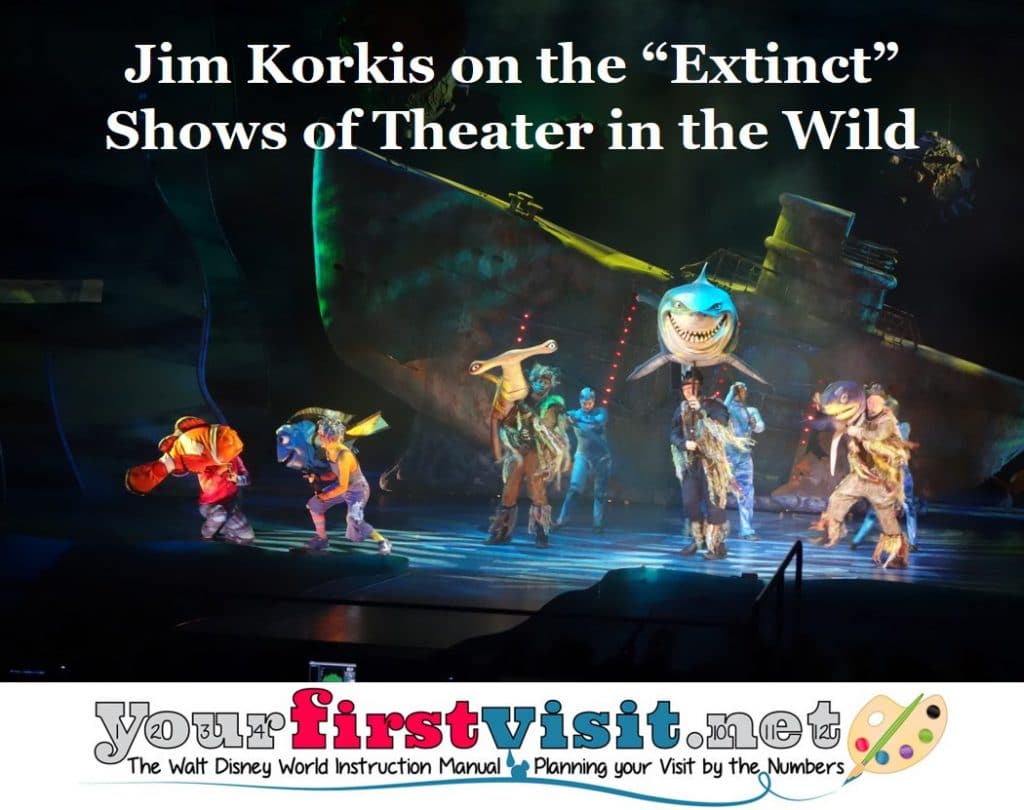
It featured costumed characters, human performers and innovative puppetry. During cast previews, the masks for characters had not been finished so audiences could see the performers’ faces and loved it.
Later, when the show debuted and the masks had arrived, it seemed to lose its connection with the audience. Some of the costumes looked like bushes and trees that when positioned differently became animals.
Show Director Fran Soeder said, “I am best known as the man who brought puppetry to Walt Disney World. Over my decade in residence as a Show Director, I created The Legend of the Lion King, The Hunchback of Notre Dame, Journey Into Jungle Book and The Voyage of The Little Mermaid.
“Most of our Puppeteers were untrained but in less than five years, I created one of the largest groups of professional puppeteers in the country. Over those years there were successful collaborations with puppet designer Chuck Fawcet (ANIMAX) as well as Structural Engineer, Michael Curry (Michael Curry Design) as well as a team of New York designers which included Scenic Designer James Leonard Joy and Lighting Designer Natasha Katz.”
After a year, Journey Into the Jungle Book was replaced with the high-energy half-hour Tarzan Rocks show directed by Reed Jones which didn’t retell the story of the animated feature, but rather was more of a rock concert experience revue that focused on the relationship between Tarzan and Jane.
The audience was told that it was the “Two Worlds Concert Tour”. The show was to help promote the release of the animated feature a few weeks earlier, and obviously the story of Tarzan’s jungle world was a good fit for Disney’s Animal Kingdom.
At one point, Imagineers pitched the idea of an inverted roller coaster that would have guests mimic swinging on vines like Tarzan through the jungle, but it was eventually determined to be cost prohibitive and take too long to build. In contrast, the live show could be put together quickly to leverage interest in the release of the film.
The show included gymnasts, singers, dancers, aerialists, roller-blading monkeys who went into the audience like in the play Starlight Express, in addition to a scene where Tarzan and Jane swirled on rope vines in an aerial ballet dance high above the stage like at Cirque de Soleil. During the run of the show there was a pin and a medallion coin available for sale.
The songs performed by a live band were all from the film and included You’ll Be in My Heart, Son of Man, Trashin’ the Camp (with Terk and a dancing back-up group), and Two Worlds.
The show ended when a musical show devoted to the animated feature film opened on Broadway in 2006 and the theater was slated for construction work so that it could be enclosed.
* * * * *
Thanks, Jim! And come back next Friday for more from Jim Korkis!
In the meantime, check out his books, including his latest, Disney Never Lands, and about planned but unbuilt concepts, and Secret Stories of Walt Disney World: Things You Never You Never Knew, which reprints much material first written for this site, all published by Theme Park Press.
Follow yourfirstvisit.net on Facebook or Twitter or Pinterest!!
June 12, 2020 No Comments
A Friday Visit with Jim Korkis: The Discovery River Boats at Disney’s Animal Kingdom
Welcome back to Fridays with Jim Korkis! Jim, the dean of Disney historians, writes about Walt Disney World history every Friday on yourfirstvisit.net.
THE DISCOVERY RIVER BOATS
By Jim Korkis
Things at Walt Disney World sometimes disappear quickly like Here Come the Muppets at Disney’s MGM Studios, the Astuter Computer Revue at Epcot and The Journey Into the Jungle Book live action show at Disney’s Animal Kingdom, all of which lasted just a year.
Also at Disney’s Animal Kingdom, the infamous Discovery River Boats that was an opening day attraction in April 1998 were gone by August 1999 making it officially the first DAK attraction to close.
The Discovery River Boats was originally intended to be a much more ambitious experience, with previews of the planned-to-be-upcoming Beastly Kingdom along its watery journey, including encounters with a unicorn, a kraken that would attack the boat (only one boat was fitted with the necessary mechanics for that experience), and the head of a fire-breathing dragon inspired by the one at Disneyland Paris.
Remnants from that concept that were seen on the final version included a statue of a twelve foot tall white unicorn rearing up on its two rear legs, and the infamous Dragon Rocks, a structure of rocks that looked vaguely like a dragon streaming water out of its mouth. Located a little further north of the old Camp Minnie-Mickey bridge was a large area of volcanic rocks on the left bank of the river that looked like a cave entrance.
As the boat approached, smoke billowed from the cave, thunderous roars were heard, and massive flames shot out from inside the cave suggesting it was the lair of a dragon. Sensors along the bank triggered by the boat enabled those show effects.
Budget cuts resulted in the ride becoming more of just a one-way transportation system between the dock at Safari Village near Dinoland U.S.A. and the Upcountry Landings dock in Asia. The trip took approximately seven to ten minutes and was similar to the Friendships at the World Showcase Lagoon, a leisurely cruise that was an alternative to, but took longer than just walking.
Since there was a skipper telling bad jokes and sharing information about the park, guests expected it would be something more like the Jungle Cruise, especially since the boats looked similar in design. Guests were very disappointed that it wasn’t such an experience, especially when long boarding lines originally resulted because of the misunderstanding.
There were seven boats that were named Manatee Maiden, Leaping Lizard, Scarlet Flamingo, Otter Nonsense, Hasty Hippo, Crocodile Belle, and Darting Dragonfly.
Jack Plettinck was in charge of taking the shiny new boats from a manufacturer in Seattle and making them seem well-worn. It had to seem that they had survived dings and dents from moorings, docks, submerged logs and angry animals. He even applied acrylic rust to add to the illusion.
Guests did see a few things on the voyage around the Tree of Life, including a series of hot springs geysers along the shores of Africa, animal water sculptures at the Discovery Lagoon, and a large audio-animatronics Iguanodon playing in the water near DinoLand U.S.A. that foreshadowed the Countodwn to Extinction attraction where that dinosaur plays a key role in the story.
The Iguanodon animatronic was later stripped of its skin and sent to Walt Disney Studios Park at Disneyland Paris as a prop in the boneyard of the Studio Tram Tour. The unicorn statue was sold to a private collector.
The attraction was renamed in November 1998 to the Discovery River Taxi to emphasize it was just transportation. Animal handlers with small animals who answered questions were added on the boat as part of the park’s animal education initiative but it did not prove to be a guest satisfier.
In March 1999, the attraction was once again renamed and was called Radio Disney River Cruise playing commentary from Radio Disney disc jockeys Just Plain Mark and Zippy with music that the guests were told was being broadcast from the top of the Tree of Life. It wasn’t.
When the attraction finally closed, the boats were stored in a backstage marina and the docks used occasionally for character meet-and-greet opportunities or additional seating. Two of the boats were later relocated to Magic Kingdom’s Contemporary Resort where they were re-purposed for a Pirates & Pals fireworks voyage on Bay Lake and the Seven Seas Lagoon.
* * * * *
Thanks, Jim! And come back next Friday for more from Jim Korkis!
In the meantime, check out his books, including his latest, Disney Never Lands, and about planned but unbuilt concepts, and Secret Stories of Walt Disney World: Things You Never You Never Knew, which reprints much material first written for this site, all published by Theme Park Press.
Follow yourfirstvisit.net on Facebook or Twitter or Pinterest!!
June 7, 2020 No Comments
yourfirstvisit.net to those on a once in a lifetime trip to Walt Disney World: Delay, for now
FIRST TIMERS WHO MAY NEVER RETURN SHOULD AVOID WALT DISNEY WORLD, FOR NOW
I built this site with a particular audience in mind: first time visitors to Walt Disney World, and in particular first time visitors to Walt Disney World who might never be able to return.
Disney World has announced a limited, staggered, partial and complicated re-opening to guests beginning in July. Given both the limitations and complexities that I see, I can’t recommend that first timers go to Walt Disney World for a once in a lifetime trip until the experience promises to be much better.
I don’t know when that will be.
Returning visitors who know what they are getting into, know what they will be missing, know how to navigate Disney World, are willing to comply with its requirements, and are willing to waive liability and otherwise accept the consequences of their choice to be in Disney World can, I think, still have fun.
DISNEY WORLD RE-OPENING PLANS
The Disney World theme parks will begin re-opening in July, the Animal Kingdom and Magic Kingdom on July 11 and Disney’s Hollywood Studios and Epcot on July 15. Right now, there is no opening date for the water parks.
The Disney Vacation Club Resorts and Fort Wilderness Resort will re-open on June 22. Right now, there is no re-opening date for the rest of the resort hotels. I suspect that Disney has plans regarding the other resort hotels, but does not yet know if it can staff to its plans.
Many have speculated that given capacity limits in the parks, some resorts will remain closed to lower total resort operating costs. I suspect that instead we will see many resorts partially open, as social distancing—especially in the pools, dining venues, lobby, bus stops etc.—will be easier in many partially-opened resorts than in fewer fully-opened resorts.
OPERATING HOURS
The parks as of now are scheduled with staggered openings and closes—presumably to lessen the demands on the transportation system
- Animal Kingdom: 8a-6p
- Magic Kingdom: 9a-7p
- Hollywood Studios: 10a-8p
- Epcot: 11a-9p
This of course also has the effect of greatly shortening operating hours—compared to mid-July last summer, each park is open 2-3 hours less per day—in effect removing an entire park out of capacity.
All Extra Magic Hours have been cancelled.
ATTRACTIONS THAT WILL BE AVAILABLE
The parks will re-open with no parades, no evening spectaculars, and no character meet and greets. Some of these possibly will return fairly soon, based on what we’ve seen in Shanghai.
It is unclear how many individual other attractions will be re-opening when the parks re-open. The balance among whether an attraction is open or not likely will be a factor of
- How many cast members are willing to return to work (pre-existing conditions and/or age factors may make a return to a high-people-exposure environment unwise for some full and part time staff, and staffing from Disney’s College program is currently absent). This affects Disney’s overall ability to staff its property
- The operating costs of an individual attraction, and
- The extent to which an attraction draws people away from congregating elsewhere.
I am most concerned about the indoor theater-style shows, which a little math will tell you that with every other row closed, and six feet between parties in open rows, will be lucky to serve around 25% of capacity.
DINING
All restaurant reservations and FastPass+ reservations have been cancelled. FastPass+ is not expected to come back soon, as the capacity of its queues is likely to be used for social distancing.
Restaurant reservations will likely re-open once Disney has a better sense of when resort dining will re-open, how many people it will allow on property, and what each venue’s practical capacity after social distancing is. The window for reservations will then shift to 60 days from the current 180 days.
All dining plans have been cancelled, and will not be available for some time.
OTHER COMPLEXITIES TO THE REOPENING
All folks intending to enter a park must sign up separately for a reservation for that park. (This is in addition to whatever one’s tickets might say about dates; no further details are yet available.) It is unclear right now how many people will be allowed into the parks each day, either initially or as experience builds.
All entering a park two years old or older will be required to wear masks, and masks will be required in the resort hotels except when one is in one’s room (the normal exceptions for eating and drinking will be present—it is unclear if there will be exceptions for being in a pool).
Given Disney’s agreements with its unions re requiring masks of guests, its obligation to its staff to provide a safe environment for them, and the liability issues it can face on these matters, I expect it to be much firmer in enforcing the mask requirements on its guests than many other do. I don’t see the mask requirement going away until either the science on the efficacy of cloth face coverings in protecting others (in particular, protecting cast members) changes its balance of findings, or the infectious environment changes.
Disney World is currently accepting no new ticket or hotel bookings other than for DVC point holders in its DVC resorts. Once it has a firm view (e.g. from knowing how many cast members can return) of its starting capacity, and has seen a full wave of cancellations related to for example the mask requirements, shorter and staggered park hours, the known experiences that will not be available when the parks first re-open, it will know—at least in the short term—whether it needs to cancel existing reservations, or can instead re-open to new reservations.
Follow yourfirstvisit.net on Facebook or Twitter or Pinterest!!
May 31, 2020 8 Comments
A Friday Visit with Jim Korkis: The Gardens of the Walt Disney World Resort
Welcome back to Fridays with Jim Korkis! Jim, the dean of Disney historians, writes about Walt Disney World history every Friday on yourfirstvisit.net.
YOUR PERSONAL DISNEY LIBRARY (29)
By Jim Korkis
- Gardens of the Walt Disney World Resort by Dee Hansford
One of the things that makes an experience at a Disney theme park so different from other entertainment venues is the landscaping.
In 1985, I got a chance to interview Director of Disney Landscape Design Bill Evans. He told me, “(Walt Disney) wanted a lot of green plant stuff. That was one of the elements Walt felt would separate his park from the Coney Island format. This was to be a park that would be clean and beautiful and colorful and a very pleasant place to be. We kept this in mind when we set about to put a green frame around all those adventures and rides.”
I doubt many Disney fans consciously realize that Walt used the word “park” to describe Disneyland, because he intended it to be like the best of the city parks he had seen in his travels around the world with lots of well-maintained lawns, impressive trees, a wide variety of colorful flowers and more. Disney Legend Evans understood that philosophy and incorporated it into every Disney theme park worldwide, including Walt Disney World.
Evans authored the hardcover seventy-two page book Disneyland World of Flowers in 1965 to help guests appreciate what Walt Disney himself described in the foreword as a “tour of the Park’s unique international botanical collection.”
Of course, there are significant differences between Disneyland and Walt Disney World, including the climate and soil, that dictate certain horticultural choices. In 1988, the 211 page hardcover Gardens of the Walt Disney World Resort, with significant input from horticulturist Katy Moss Warner, was released.
Warner was Director of Disney’s Horticulture and Environmental Initiatives at the Walt Disney World Resort in Florida. With a team of nearly 700, she was responsible for the landscapes of Florida’s four theme parks, fifteen (at that time) resorts and more than 70 miles of roads on the roughly 30,000-acre property.
What makes that even more impressive is that when she first started with the department, it was considered part of the Disney custodial team and only operated after the guests had left for the evening.
From 1976 to 2000, she provided the leadership to ensure that Disney’s horticultural traditions of beautiful gardens and environmental responsibility were sustained in Florida. She was the champion that guided the department to be a more significant and integrated part of the company.
She was responsible for starting the Epcot International Flower and Garden Festival in 1994, as well as many other accomplishments including expanding the concept of “themed” landscaping. After leaving Disney she continues to be active in horticulture like being the president of the American Horticultural Society and America in Bloom.
The premise of the book is that the landscaping at WDW is “magical…special places where the talents of Disney’s landscape architects, landscape construction personnel and landscape maintenance cast members combine to create living and changing scenery on a larger-than-life scale…which can be appreciated as unique international botanical collections…or simply enjoyed for their beauty.”
While the book is overflowing with large, colorful photos by Gene Duncan, the text by Dee Hansford is both lyrical and informative. Where else would you find the information that The Toy Soldier shop in the United Kingdom pavilion was modeled after Sir Walter Scott’s Abbotsford Manor or that the waterfall in the Norway pavilion was incorporated because it is “a symbol of the importance Norwegian people place on their wonderful native woodlands and of their regard for the rivers and streams that nurture their land’s growth”?
Of course, since this book was published in 1988, it only covers the Magic Kingdom and Epcot, and so is usually considered outdated and forgotten by those Disney fans who are eager each year to visit the annual Epcot Flower and Garden Festival.
As I have mentioned before, just because a book is old does not mean that it doesn’t still contain valuable information that has not appeared elsewhere. While the wonderful landscaping of Walt Disney World is best enjoyed in person, this book is a great way to better understand what someone is seeing while they are there.
* * * * *
Thanks, Jim! And come back next Friday for more from Jim Korkis!
In the meantime, check out his books, including his latest, Disney Never Lands, and about planned but unbuilt concepts, and Secret Stories of Walt Disney World: Things You Never You Never Knew, which reprints much material first written for this site, all published by Theme Park Press.
Follow yourfirstvisit.net on Facebook or Twitter or Pinterest!!
May 31, 2020 No Comments
A Friday Visit with Jim Korkis: Wonders of China
Welcome back to Fridays with Jim Korkis! Jim, the dean of Disney historians, writes about Walt Disney World history every Friday on yourfirstvisit.net.
WONDERS OF CHINA AT EPCOT
By Jim Korkis
When Epcot’s China Pavilion opened in 1982, it featured a Circle-Vision 360 degree movie called Wonders of China: Land of Beauty, Land of Time.
Wonders of China gave non-nationals a glimpse of areas of China that had rarely been seen before by outsiders. This film closed in March 2002 and was replaced in May 2003 with a new movie called Reflections of China.
The Disney crew that created Wonders of China was the first Western film group to be allowed to film certain sites. During early negotiations, the Chinese government denied permission to film any locations considered “strategic,” such as bridges, tunnels, and trains, or filming anywhere near an military base.
By the end of production, the crew had proven to be cooperative, and the footage shot was so impressive that the government gave permission for a shot of train coming out of a tunnel and across a river bridge, as well as another shot that was made of peasants and water buffaloes on the property of an Army base.
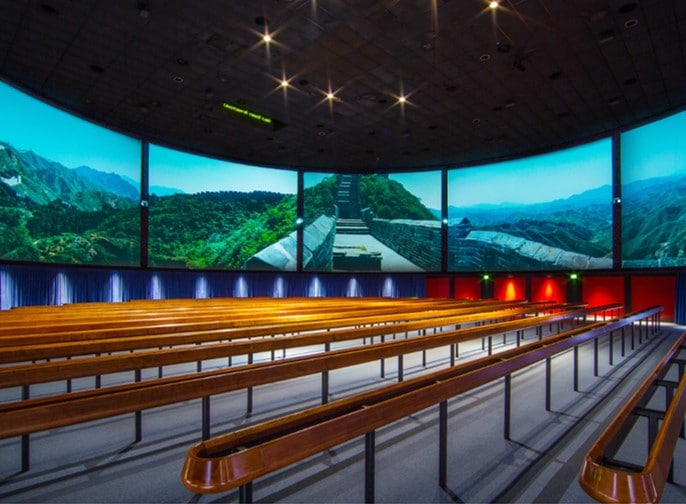
(c) Disney
The final nineteen minute presentation featured such landmarks as Beijing’s Forbidden City; vast, wide-open Mongolia and its stern-faced tribesmen; the 2,400-year-old Great Wall; the eight-centuries-old Great Buddha of Leshan; the muddy Yangtze River; and the 3,000-year-old city of Suzhou, whose location on the Grand Canal, which is generally believed to be the largest man-made waterway in the world, encouraged Marco Polo to call it the Venice of the East.
In addition, there were shots of Hangzhou, where a handful of Chinese are shown doing their morning exercises along the river’s edge. Also shown are Huangshan Mountain, wreathed in fog; the Shilin Stone Forest of jagged rock outcroppings in Yunnan Province; Urumqi, whose distance from the sea in Xinjiang Province earned it the title of the most inland city on earth; Lahsa, in Tibet, and its Potala Palace, boasting a thousand rooms and ten times that many altars.
Also shown were the Reed Flute Cave and the bizarrely shaped hills of Kweilin above, to say nothing of the very European-looking city of Shanghai. To complete the picture, there are fields of snow and of wheat, high meadows and beaches dotted with tropical palms, harbors and rice terraces, calligraphers, checkers and Ping-Pong players, lightning-fast acrobats, championship horseback riders, camels and a panda bear, glittering ice sculptures, and millions of bicycles.
The Birnbaum guide stated, “Every step of the way, the film crews were besieged by curious Chinese, even in empty Mongolia. For the Huangshan Mountain sequence, which lasts only seconds, the crew and about three dozen hired laborers had to carry the 600-pound camera uphill for nearly a mile. The Chinese government would not permit Disney cameramen to shoot aerial footage in some areas, so Chinese crews were sent aloft to record the required scenes, first on videotape and later—after approval from the Disney director in charge of the project—on film.”
The narrator and host of Wonders of China was the character of Li Bai, one of the greatest of Chinese poets from the 8th Century Tang Dynasty who spent much of his life traveling. Using this character helped to unify the many disparate sequences. In the film the voice of the character is portrayed by Keye Luke, an artist and film actor best known for being the “Number One Son” in many Charlie Chan films and as the Chinatown shopkeeper Mr. Wing in Gremlins (1984).
Wonders of China also played in the World Premiere Circle-Vision theater in Tomorrowland at Disneyland from 1984 to 1996.
* * * * *
Thanks, Jim! And come back next Friday for more from Jim Korkis!
In the meantime, check out his books, including his latest, Disney Never Lands, and about planned but unbuilt concepts, and Secret Stories of Walt Disney World: Things You Never You Never Knew, which reprints much material first written for this site, all published by Theme Park Press.
Follow yourfirstvisit.net on Facebook or Twitter or Pinterest!!
May 24, 2020 No Comments



